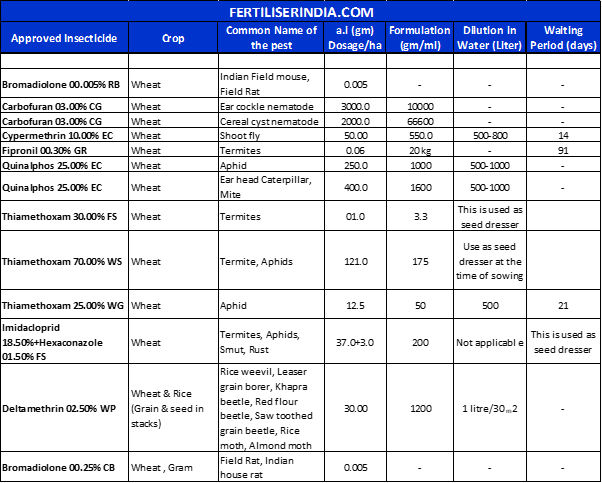Insecticide For Wheat Crop
Many wheat producers in South Dakota have adopted more intensive management practices in the last few years, including an early season application of fungicide and, in some cases, insecticide.
While there are several insect species capable of impacting production in SD wheat fields, the most prevalent found early in the growing season have been bird cherry oat aphids, and English grain aphids. The aphids do not overwinter in the state and migrate in from the south and most early-season damage is caused by direct feeding on foliage. The early season threshold for chemical application is 20-30 bird cherry oats per stem and 30-50 English grain aphids per stem. However, in most seasons, aphid populations in the region are very low, slow to develop, or are simply controlled by natural events such as a late frost or beneficial insects.
Pyrethroid class insecticides are commonly used to treat these insects. One pyrethroid, cyfluthrin, was tested at experiment station trials conducted in Minot, North Dakota. The trials demonstrated a general reduction in aphid populations when plots were treated with early insecticide, but the reductions did not have a significant impact on grain yields. In another study, performed in eastern ND, a 1.5 bu/acre increase in spring wheat yields was observed when adding insecticide to an application of fungicide just prior to stem elongation, despite a lack of insect pressure. In some cases, synergistic effects between fungicide and insecticide products, specifically, pyrethroids, have been noticed to increase the toxicity of insecticides. However, yield increases in an insect-free environment is most likely the result of a beneficial prophylactic effect for insecticide on spring wheat, rather than a synergistic increase in fungicide efficacy.
While insecticide products are relatively inexpensive, it is prudent to scout fields, monitor weather forecasts, and plan accordingly in order to prevent unnecessary chemical applications. In addition, the prophylactic use of insecticides increases the selection pressure for the development of resistance on the pests that are present at low populations at the time of application. If thresholds are not reached, it is better to let the natural enemies of the pests, such as lady beetles, to continue population maintenance.
Insecticide For Wheat Crop
Wheat, or “wheatgrass,” is a member of the grass family Poaceae. It is one of the most widely grown grains worldwide and is a staple food for humans, being eaten as far back as 7000 BC.
Wheat contains a variety of nutrients including protein, carbohydrates, fat and dietary fiber. The grain itself is made up of three parts: the bran (outer layer), endosperm (inner layer) and germ (embryo). The bran provides vitamins and minerals while the endosperm provides starch and protein. The germ contains oils that are high in unsaturated fats.
Insecticides are chemicals that kill insects. They can be used to prevent or control pests on plants like wheatgrass or they can be used to kill insects after they’ve already infested plants such as wheatgrass. Insecticides come in a variety of forms including sprays, dusts and powders.
List Of Insecticide For Wheat Crop
Additional Info :
Additional Info :
| Release Date | 2019-02-19T00:00:00.000Z |





